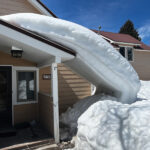Perforation patterns can enhance architectural metal wall panels, sunshades and decorative products. Finish types and colors can complement and accentuate distinctive designs. Choosing durable finishes also contributes to the material’s performance, sustainability and longevity.
Best practices and considerations when selecting perforated metal finishes

(Photo courtesy of Dri-Design and Linetec)
Liquid-based architectural painted coatings are available in a nearly unlimited choice of colors. Some of the largest coating applicators have libraries with more than 55,000 paint colors. If a project requires an exact color match, such as to a customer’s brand, confirm the finisher has in-house custom-matching and in-house blending capabilities. Experienced applicators may offer options including mica and metallic paints that sparkle and shine, or textured finishes that mimic terra cotta, or coatings infused with antimicrobial protection.
Anodized finishes highlight the natural metallic appearance of the aluminum. The architectural anodize color palette typically is limited to clear, silver, black, champagne and bronze tones. Proprietary anodize finishes extend this range to rich copper and Bordeaux hues. Unlike painted finishes that coat and adhere to the metal surface, anodize finishes are an integral part of the aluminum. The anodic coating produced is extremely durable.
The hardness of its surface is comparable to a sapphire—the second-hardest substance on Earth, next to a diamond. This characteristic makes anodize a finish of choice for use in high-traffic areas where wear-resistant and abrasion-resistant properties are important.
For Best Results
Here are tips to achieve the best results in finishing perforated aluminum for architectural applications.
Specify for high performance. The Fenestration and Glazing Industry Alliance (FGIA) publishes the industry-leading specification standards for architectural finishes. To ensure the highest performance and greatest longevity, specify 70% PVDF resin-based architectural coating systems to meet AAMA 2605 and Class I anodize finishes to meet AAMA 611.
Perforate, then finish. Whether perforating, cutting, curving or otherwise shaping the metal, most finishers recommend material forming takes place before it is finished to ensure optimal coverage, adhesion and performance. Be aware this sequence may be a warranty requirement.
Don’t go too small. If the perforation is very small, the finish may cover the open area and negate the intended appearance. In certain applications—such as when panels are used for ventilation, sound mitigation or shading—a clogged opening can affect the product’s functionality.
Get rid of grease. Remove residual lubricants, grease and oils before sending the perforated metal material to the finisher. A finisher’s standard pretreatment cleaning may be unable to remove remaining lubricants, which can cause issues with a consistent, quality finish.
Finish all surfaces. With perforated metal, there’s the front, the back, the outer edges and the inner edges of the cut opening. Request 360-degree or two-sided finishing to ensure every surface has the proper coverage.
For projects with sustainable goals, perforated, finished metal products may offer additional advantages. Vertical and horizontal shading systems can contribute to daylighting and energy efficiency goals. Larger, perforated open areas at eye level can optimize light and views. Panels and other perforated architectural products can be manufactured with recycled metal content, and upcycled at the end of their useful life on a building.
Environmentally responsible liquid paint applicators can use a 100% air capture system and safely destroy the VOCs with a regenerative thermal oxidizer, so there is no adverse environmental impact. Anodized aluminum does not contain VOCs; it is an inert, noncombustible material and poses no health risks.
Tammy Schroeder, LEED Green Associate, is the director of marketing at Wausau, Wis.-based Linetec. To learn more, email tammy.schroeder@linetec.com or visit www.linetec.com.






